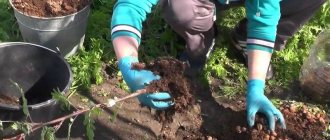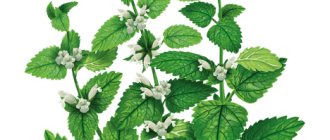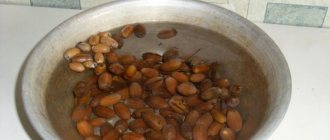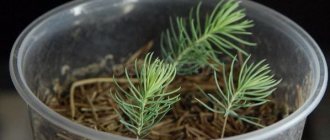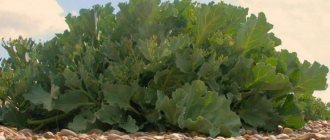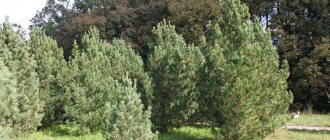Description of the plant
Katran is a plant that reaches a height of up to 120 cm. After a year, a rosette of leaves appears. Their number increases every year.
The roots of the plant penetrate deep into the soil in search of moisture. This explains the bush’s resistance to winter cold and summer drought. The root is cylindrical, fleshy, with white pulp. Its length is on average 50 cm, weight is just over a kilogram.
The stem is bare, branched, covered with a slight coating of wax. The leaves are pinnately divided, petiolate or forked.
The katran plant has a fruit that is a spherical pod (indehiscent). The seeds of the plant are pieces of the fruit. They are quite large - their diameter reaches 10 mm, the fruit shell is hard and does not separate.
Katran is a plant, a photo of which you can see in our article, primarily light-loving, heat- and cold-resistant. It easily tolerates even very harsh winters. Seeds germinate at a fairly low temperature (3°C), seedlings tolerate frosts down to -5°C. However, katran feels most comfortable at a temperature of 18-25 °C. Growth begins in early spring.
Secrets of agricultural technology when growing katran
Katran refers to vegetables that have relatively recently settled in dachas and are unfamiliar to most gardeners. The culture is similar to horseradish and is not inferior to it in taste and nutritional properties. Considered a horseradish substitute.
The plant is a storehouse of vitamins and microelements. The spicy taste and aroma of the vegetable is determined by the essential oil it contains.
Katran is used in cooking, as well as folk medicine and garden decoration.
To get a good harvest, it is important to know the secrets of agricultural technology and adhere to the rules of growing and caring for the plant.
Description
Katran belongs to the perennials of the Cruciferae, or cruciferous (brassica) family, but is often grown as a biennial crop. Closest relatives:
- turnip;
- cabbage;
- radish;
- radish.
Known as Tatar or Oriental horseradish. In the natural environment they are found in Crimea. It grows wild in eastern Africa, southwestern Asia and Europe. Representatives of the species are annual and perennial herbs and shrubs. After fruiting, the katran dies.
The culture has a bare, densely branched stem with a waxy coating, which reaches 1.5 m. The green leaves are large, pinnately divided, petiolate. They form a semi-raised rosette in the first year. The flowers are white, the root is taprooted, thickened, cylindrical. A juicy, smooth root crop up to 3 cm in diameter with creamy pulp extends into the soil up to 2 m.
The stem is formed in the second year. Flowering dates occur at the beginning of June. Peak decorativeness is 50-65 days. The vegetable has small white flowers that are collected in a racemose inflorescence. The culture is characterized by both self-pollination and cross-pollination.
The fruits, in the form of a pale yellow pod with one seed, ripen in the summer at the end of August. The fruit resembles a nut with a diameter of 2-10 mm. Characterized by extended ripening of fruits, the valves of which do not open. The diameter of the spherical brown seeds is 1-2 mm. When ripe, they fall into deep dormancy and do not germinate even in the most favorable conditions.
The thick, fleshy rhizome weighs about 800 g. The culture is not afraid of either heat or cold.
Useful properties and composition
Katran is tastier than horseradish and richer in chemical composition. All parts of the plant containing:
- protein and phytoncides;
- fats and essential oils;
- starch and mineral salts;
- inulin and pectin;
- carotene and nicotinic acid;
- vitamins B1, B2 and C.
Vegetable rhizome per 100 g of raw material includes:
- sugar (9%);
- ascorbic acid (45-90 mg);
- dry matter (34%).
This gives it a similarity to horseradish roots.
How to grow
To grow katran in your summer cottage, it is important to create favorable conditions for the plant.
They note that katran is undemanding to the soil. Prefers loose, non-acidic sandy loam or light loamy soil. Heavy soil is not suitable for planting: seed material takes a long time to germinate and poorly, acidic soil will provide the vegetable with poor growth and disease.
The planting site for the vegetable is chosen to be open, illuminated by the sun. The plant does not tolerate darkening.
Katran grows and develops at air temperatures of +19…+25 °C. Seed germination occurs at +4 °C. The plant is winter-hardy: the seedlings tolerate frosts down to -6 °C.
Optimal predecessors for vegetables:
- potatoes and pumpkin;
- beans and cucumbers;
- peas and eggplants.
How to plant
This unpretentious crop can be grown by inexperienced gardeners in open ground. Knowledge of the peculiarities of planting and caring for katran in open ground will allow you to get a good harvest.
Methods of propagation of katran: seeds, cuttings, seedlings.
Planting by seeds
The seed is prepared in advance for planting. To stratify the seeds, they are soaked in a solution of potassium permanganate (1%) or in water, the temperature of which reaches +18...+20 °C. The process takes 2 hours. Then the seeds are mixed with wet sand in a ratio of 1:3. Suitable storage location: basement or refrigerator. Store at 0 ° C for 95-100 days.
Select seeds no smaller than a pea: small specimens do not germinate.
When planting in autumn, seed material is not processed. In winter, they harden naturally. Pre-winter sowing is the best option.
Before sowing the plants, dig up the bed and add:
- manure (3-4 kg/m2);
- potash and phosphate fertilizers (35-40 g/m2).
Suitable complex fertilizers:
- Kemira-universal;
- Azofoska;
- Kemira is super.
When digging, add wood ash (0.3-0.5 kg per m2) to the acidified soil.
When growing vegetables, you do not need to use special agricultural techniques or tricks. The seed sowing depth is 3 cm, the row spacing is 65-70 cm. The belt method is also used. In each tape, 3 lines are made every 35 cm, and a distance of 60 cm is maintained between the tapes.
Ridges or ridges are most suitable for sowing. Peat and humus are used to mulch the soil in rows, especially during winter sowing. Sprouts have appeared - it’s time to mulch again with humus.
Propagation by cuttings
They are obtained by cutting off the lateral root shoots. Suitable specimens are those with a length of 20−25 cm and a diameter of less than 1 cm. Cuttings are harvested in the fall during harvest. Don't forget to mark where the top and bottom of the plant are. The landing is not delayed. The propagation method is suitable for warm areas where air temperatures in winter rarely drop below -15 °C.
First, the cuttings are planted in a greenhouse or greenhouse. It is important to know how to choose a seedling. As a rule, healthy, powerful specimens are abandoned during the thinning process. Then transplant into open ground. Do not allow damage to young crops by the cruciferous flea beetle.
35-45-day-old seedlings with a rosette of 4-5 leaves are transplanted to a permanent place. The root size is 20 cm, planting using a peg. It is important that the growing point is at soil level.
A short root and shallow planting are unsuitable for getting a high yield in the second year after planting the seedlings.
Distinctive features of this growing method:
- deterioration of rhizome quality;
- labor intensity of the process.
How to care
High-quality plant care involves thinning the rows at the stage of two true leaves: the interval between crops is approximately 30 cm. With the slow development of the vegetable at the very beginning, it is important to loosen and weed between the rows.
Watering is carried out as needed. At the end of May, water abundantly: 30 l/m2.
The appearance of pests marks the beginning of the fight against them. Use pesticides and spray according to instructions. At the height of the summer season, measures are taken to combat cabbage whites and leaf-eating caterpillars.
Three-time spraying against leaf-eating caterpillars is carried out at intervals of 2 weeks with a solution of superphosphate extract (0.1%) with potassium chloride (0.5%). 10 liters of water are mixed with 10 and 5 g, respectively. Treatment with decoctions and infusions of insecticidal crops is appropriate. To destroy caterpillars, benzophosphate (60 g) or karbofos (75 g per m2) is used.
To protect plants from the cruciferous flea beetle, they resort to joint plantings of lettuce and katran.
What should you feed?
The first time vegetables are fed is when the crops are thinned out. You will need ammonium nitrate at the rate of 5-10 g/m2. The next application of fertilizing is carried out at the stage of 5 true leaves. Potassium salt (9-15 g/m2) and ammonium nitrate (6-7 g/m2) are used. The second half of the growing season is just right for potash fertilizers.
In the absence of rain, applying fertilizer in liquid form is appreciated.
How to harvest
Harvesting occurs in the fall, at the end of September. The crop is harvested both in the first and second years of crop growth. You will need to pre-cut the leaves. The length of the root reaches 60 cm. Digging with a garden fork is necessary to avoid damage.
Proper care guarantees a yield of 1 kg/m2. A refrigerator is suitable for storage, as well as a trench, a cellar and digging in the roots with moistened sand. Air humidity is not higher than 85%, temperature does not exceed +4-5 °C.
Digging up root crops is possible in early spring before the katran begins to grow. The fruits are larger in the second year, the flowering of crops and the formation of seeds affects the yield reduction.
When only the leaves are used for food, leaving the root intact, the vegetable grows for 10 years in the same place.
In ornamental gardening
Katran is suitable for decorating a personal plot. They are attracted by the lush pink and white inflorescences that remain on the bushes for a long time. They spread a strong honey smell and attract pollinating insects. Heart-leaved katran is used to decorate borders and flower arrangements. Culture looks attractive in a rock garden.
Species diversity
There are about 20 types of culture in Russia. But the most common are:
- Rod-shaped.
- Stepnoy (Tatar).
- Oriental.
- Seaside.
Popular types:
- Tatar, or Steppe. Cultivated since the middle of the last century. The leaves are bluish-green, the height of the shoots is up to 100 cm, the white flowers are collected in wide clusters. The vegetable is grown for its rhizome, the commercial part of which can be up to half a meter long, the thickness varies in the range of 3-8 cm. It weighs about 600 g.
- Seaside, or Crambe maritima. A common variety. Differs in aromatic leaves: basal, apical, stem. The lower foliage is large in size, petiolate. The dimensions of the stem leaves are medium, and the apical leaves are small. The color of the flowers is white.
- Heartleaf (Crambe cordifolia). It has highly decorative qualities. The height of the bushes reaches 150 cm. Large leaves have heart-shaped plates. When the leaves open, they turn purple. Then the color turns green. Peak decorativeness: June - July. Valued in the decoration of white gardens.
Varieties available for sale:
Chord
Leaves with a delicate taste. Mass of aromatic roots with a whitish tint—up to 250 g.
Picadrome
It is cultivated for its succulent roots, which grow up to 40 cm and weigh up to 900 g. The yield of vegetables per 1 square meter is 4 kg.
In alternative medicine
Katran is a useful crop. Used by folk healers as a healing agent to:
- increase appetite;
- improve digestion;
- fight gastrointestinal dysfunctions;
- resist colds;
- protect against scurvy;
- heal cuts and wounds.
An indispensable assistant in getting rid of freckles, which cause trouble for their owners.
The vegetable is distinguished by its ability to remove salt from the body.
For a medicinal prescription you will need:
- roots ground into a meat grinder - 1 kg;
- honey - 500 g;
- cold water - 4 l.
The ingredients, except honey, are mixed and boiled for 5 minutes over low heat. Honey is added to the strained mixture. Take the medicine 1 glass daily. Store the healing substance in the refrigerator. The course is repeated twice a year: spring and autumn periods.
Contraindicated for whom
Among the contraindications to the use of katran are disorders and diseases:
- liver;
- kidney;
- ulcers of the stomach and duodenum.
Use in cooking
By growing a productive plant in their summer cottage, gardeners have a chance to get a universal seasoning. The juicy roots are suitable for pickling and pickling cucumbers and tomatoes, zucchini and squash, preparing hot sauces and seasonings for fish and meat dishes. Young foliage is suitable for vegetable salads.
At the beginning of the spring season, shoots and leaves of katran are necessary ingredients in a vitamin salad. The preparation is simple. Boil in salted water, sprinkle with sunflower oil and sprinkle with crackers.
All parts of the plant are suitable for consumption raw, baked or boiled.
Meat katran
You will need:
- potatoes -500 g;
- pork - 500 g;
- grated katran - 0.5 tbsp.;
- onion - 1 pc.
All components, except katran, are mixed and simmered. A few minutes before readiness, add the grated vegetable. The result is a tasty and aromatic dish.
Apple sauce with katran
Components:
- apple - 1 pc.;
- sour cream - 2 tbsp. l.;
- katran - 0.5 tbsp.;
- vegetable oil, vinegar.
The grated apple and katran are mixed. Add vinegar, mix in sour cream and vegetable oil.
Katran gravy
Ingredients:
- butter - 50 g;
- grated katran - 100 g;
- egg yolks - 2 pcs.;
- meat broth - 250 ml;
- flour - 40 g;
- sour cream - 200 g;
- sugar, vinegar, salt - to taste.
Sprinkle the peeled and grated vegetable with vinegar. Mix the heated oil with flour and pour in the meat broth, boil. Add katran and sour cream. Sugar, salt, add vinegar. Then pour the yolks into the mixture and stir thoroughly. Serve with fish or boiled beef.
Gardeners speak positively about katran. They focus on the similarity in taste to horseradish rhizomes. The vegetable is noted to be less aggressive: it does not clog the garden plot, and the remaining roots after harvesting do not grow back in the spring. The decorative nature of the grass is attractive. In addition, it serves as a growth stimulator for other garden crops: it is enough to mulch the ground under them with katran leaves.
The vegetative part of katran is valued in livestock farming as a nutritious feed for livestock. Seeds, which contain up to 45% fatty oil, are raw materials for wax and technical oil.
Source: https://o-flora.com/katran-vyirashhivanie-posadka-razmnozhenie-i-uhod/
Growing conditions
The katran plant is quite unpretentious, it does not need a lot of heat, it easily tolerates heat and cold, and prefers an unshaded area. These properties make it possible to plant it in open ground in all regions of our country (the only exception is the northern regions).
Light soil - loamy or sandy loam - is most suitable for growing. It does not like acidic soils or nearby groundwater. Acidic soil can cause fungal infections in the plant, and swelling and growths appear on the roots.
The katran plant likes to settle in areas where potatoes, cucumbers, and tomatoes used to grow. To reduce the acidity of the soil, it is necessary to add freshly slaked lime when digging in the fall at a rate of about 200 grams per 1 square meter. m.
In addition, the plant needs to be fertilized with humus - 5 kg per 1 sq. m. Before planting, katran seeds should be heated in water at about 50 degrees to prevent the appearance of powdery mildew.
Katran Picadrome - botanical description
- Katran Picadrome is a herbaceous perennial belonging to the Cruciferous family.
- Katran Picadrome grows in European countries, Russia, and East Africa. About 20 species of katran grow wild in Russia.
- The leaves of the Katran Picadrome are bluish-green in color and have a smooth surface. The leaves are ovate in shape and pinnately dissected.
- The stem of Katran Picadrome is erect, slightly branched, capable of reaching 50 cm in height.
- The root system of the katran Picadrome is taprooted and is represented by an elongated root crop. Under favorable conditions and proper care, the root of the Katran Picadrome can reach up to 40 cm in length and 4 cm in diameter. The root crop has a regular conical shape and is brown in color with a grayish tint. Can reach a mass of 900 g.
- Katran Pikadrom is considered a fairly productive variety of katran. From 1 sq.m you can harvest up to 4 kg of crop.
- Around mid-summer, the Picadrome dogflower begins to bloom with fragrant small white flowers. But you will be able to admire the pretty flowers only in the 2nd or 3rd year after planting.
- The juicy pulp of the root vegetable of the katran Picadrome tastes similar to the pulp of horseradish. It is white in color and has a richer and more valuable chemical composition than horseradish.
- The fruit of the katran Picadrome is a pod containing 1 seed inside. When ripe, the pod bursts easily.
- Katran Picadrome considers it not only a drought-resistant plant, but also frost-resistant. With the onset of cold weather, its above-ground part dies off, and the root goes even deeper into the ground by 4 cm. This allows the plant to easily tolerate severe frosts even without special shelter.
Growing Katran from seeds
For germination, seeds need stratification, so it is better to sow them before winter - in September-October. They will germinate early, +5 °C is enough for them, the seedlings can easily withstand cold temperatures down to -5 °C.
Spring sowing will require 2 months of keeping the seeds in the refrigerator. The soil can be moistened sand. After 10 days, the container with sowing must be moved to a well-lit windowsill. Often shoots appear even in the refrigerator.
The most comfortable temperature for plant development is +21 °C.
The seedlings should be transplanted into the ground after 40 days. By this time, 5 leaves are usually formed on the katran.
Plants should be planted in rows every 40 cm, row spacing is 60 cm. Do not worry that in the first year they develop poorly. The next day, greenery appears very early, growth noticeably accelerates.
How to grow katran
Sowing katran seeds
This plant is propagated by seeds. It is best to sow it before winter, since when sowing in spring, the seeds will have to be stratified in damp sand for almost three months in the refrigerator or basement. The plant is frost-resistant and does not freeze even in the harshest winters. It is not recommended to grow katran in areas where cabbage, mustard, horseradish, daikon, rutabaga, radish, radish and other cruciferous crops previously grew.
Katran is sown with a distance between rows of at least 60 centimeters, and between plants at least 30 centimeters. The more spacious the plant, the larger the root it will grow.
If you want to get a marketable root in one season, you will have to grow seedlings. It is ready for planting when there are at least four leaves, usually a month and a half after sowing.
Conditions for growing katran
The main requirement for growing conditions is sunlight; in the shade, katran will not produce a full harvest and will be suppressed. This plant is undemanding to soil; it grows well in any soil with a non-acidic reaction, but on fertile soils a larger root grows.
Katran care
Katran is not demanding when it comes to watering. Can easily tolerate lack of moisture. There is also no need to fertilize it during the season if a sufficient amount of organic matter and complete mineral fertilizer were added during planting. During the season it is necessary to carry out weeding and loosening of the soil.
Read also: Flower beds of continuous flowering - diagrams with descriptions of flowers, Site design ()
How to grow katran
Root crops are harvested in late autumn, since the katran grows the root until the frost.
How to increase productivity
To do this, it is necessary to enhance root growth. For this purpose, the head of a two-year-old plant is cut off by 3 cm. In this case, the peduncle will stop developing, and the root crop will increase significantly.
It will reach commercial size in the second year of development. In fact, by growing katran in compliance with modern agrotechnical methods, you are guaranteed to get good root crops within a year. But do not forget that young one-year-old roots are tender and quickly wither after harvesting, so they need to be covered immediately.
How to care for katran
We have figured out how to start growing katran, all that remains is to provide the plant with quality care. In the phase of two true leaves, it is necessary to thin out the rows so that the distance between the plants is about 30 cm. At first, the plant develops slowly, and at this time it is very important to do loosening and weeding between the rows, this is the main care for the katran.
Read also: 3 mistakes when planning an orchard - SOUTHERN VEGETABLE GARDEN
In the phase when the first true leaves appear, pest control must be carried out. This horseradish-like plant is watered as needed, but at the end of May, watering is done more abundantly, at the rate of 30 l/sq.m. m.
The first feeding is necessary when thinning the plant; for this, take 5-10 g/sq. m of ammonium nitrate. In the second feeding in the phase of 5 true leaves, use 9-15 g/sq. m of potassium salt and 6-7 g/sq. m of ammonium nitrate. Potassium fertilizers should be applied in the second half of the growing season.
Katran plant - types
In our country, there are more than a dozen types of katran, but four are most often grown and used: twig-shaped, eastern, steppe (Tatar), and sea.
The three most productive are the eastern, steppe and sea. Most often, amateur gardeners prefer steppe katran or its variety, Crimean, on their site.
Katran plant - use
The leaves of the marine species are used as food. The heart-leaved katran is used as an ornamental plant from which borders are formed. Oil is extracted from the seeds of the Abyssinian variety.
Katran root crops reach commercial size by two years and become smooth and even. It is eaten as a seasoning similar to horseradish.
The roots of this plant contain 9% sugars, up to 34% dry matter, from 45 to 90 mg of ascorbic acid per 100 g of wet weight. This makes them very similar in taste to horseradish roots.
Young shoots and young leaves of the plant are eaten in early spring. They are boiled in salted water, seasoned with oil and sprinkled with crackers.
For salting and pickling vegetables (tomatoes, cucumbers, squash, zucchini), leaves and roots of katran are used.
Horseradish or katran?
Horseradish is a familiar crop to everyone. Due to its unique pungent taste and great benefits, it is widely used in cooking and as a medicine. But the problem is that the horseradish root is highly branched, and only specimens grown for many years can boast of a large size. It's either a matter of katran. It is easy to propagate by seeds, while horseradish is propagated only by small roots. In a couple of seasons, this plant produces a heavy root weighing up to a kilogram or more, and at the same time it has practically no lateral roots. It also has one more advantage - it does not spread across the site.
Growing Katran in the ground
ethnoscience
Due to the high content of vitamin C in the leaves of the plant, they are used by traditional healers as an excellent remedy to protect against scurvy. Salads are also prepared from them by mixing the leaves with carrots.
The katran plant is used to improve digestion and increase appetite. In addition, it is an excellent wound healing agent. With its help you can get rid of freckles, which cause a lot of problems for many.
Reviews
Today you learned what is remarkable about the katran plant. Reviews from gardeners about it are positive. Many people note that while the taste is completely similar to horseradish roots, this plant behaves less aggressively in the area. Many are satisfied with its decorativeness.
As for its medicinal properties, opinions are very contradictory. For some, this is a universal remedy for the treatment of “all diseases”; others question this statement. In any case, before using katran for medicinal purposes, consult your doctor.
Basics of care
It should be noted that, like horseradish, katran is completely unpretentious. All care comes down to the following activities:
- weeding;
- loosening and hilling;
- regular watering immediately after planting;
- additional watering during bud formation;
- At the beginning of the season and a month later, nitrogen fertilizer is applied.
Apply nitrogen fertilizers strictly according to the norm. Their excess can negatively affect the size of the roots and cause excessive branching.
Good to know: an adult plant has a powerful root and easily tolerates even prolonged drought.
In all other respects, the plant is unpretentious. Katrana bushes can grow in one place for at least 6 years.

